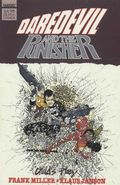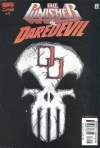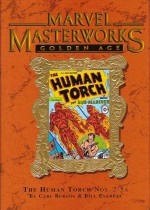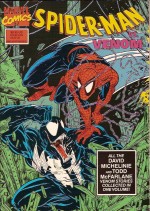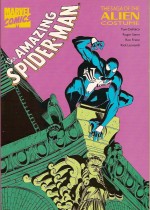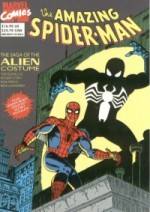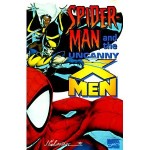
By Howard Chaykin, Christos N. Gage, Benjamin McCool, Peter Milligan, Mike Mayhew, Ty Templeton and many various (Marvel/Panini UK)
ISBN: 978-1-84653-495-9
Marvel’s 2011 multi-part, inter-company braided mega-saga focused on Captain America, Thor and the Avengers, recounting how an ancient Asgardian menace resurfaced, possessing a band of the planet’s mightiest mortals and compelling them to wreak unimaginable death and destruction on the global population whilst he drank the terror the rampage generated.
To accompany and expand the series Marvel released a seven-part anthology miniseries which offered brief continuing sagas and snapshots which focused on the peripheries of the main event.
Although every issue contained a chapter of each story-strand, this tome sensibly organises the tales into discrete story-blocks so with the “The Worthy†– Sin, the Hulk, Juggernaut, Absorbing Man, Titania, Attuma, Grey Gargoyle and Thing – storming through cities awash with slaughter in other books, Fear Itself: the Home Front opens with disgraced teen hero Speedball who had caused the deaths of six hundred innocent civilians and sparked the Civil War and Superpowers Registration Act clandestinely returned to the town of Stanford where his impulsive act had turned into a metahuman massacre…
Guilt-wracked the lad had been sneaking back in his secret identity of Robbie Baldwin to work as a volunteer, but when he is exposed by the mother of one of his victims the outraged citizens want to lynch him. Lucky for him a horde of escaped super-criminals pick that moment to turn up and the kid gets the chance to save some lives.
Not that that makes any difference to the grieving, angry people of Stamford…
And then the ensorcelled Juggernaut and Attuma hit town just ahead of a colossal tidal wave and the psychotic slaughterers The Sisters of Sin…
Powerfully written by Christos N. Gage and illustrated by Mike Mayhew & colourist Rainier Berado, ‘The Home Front’ is a splendid Coming-of-Age redemption tale, swiftly followed by four-part saga ‘The Age of Anxiety’ (by Peter Milligan, Elia Bonetti & John Rausch) as resurrected and future-shocked 1950s super-spy Jimmy Woo leads a group of similar vintage dubbed the Atlas Foundation (Sub-Mariner’s cousin Namora, Gorilla-Man, love-goddess Venus, the Uranian Marvel Boy and wonder-robot M11) against an upsurge of hate-group attacks. Something is causing all the supremacists to rise up in a wave of venom and hatred and it all leads back to the Nazi cult which first found the mystic hammers of the Asgardian Serpent-god…
‘The Chosen’ by (Fred van Lente, Alessandro Vitti & Javier Tartaglia) reveals how the next generation of Avenging heroes are triumphantly Assembled by their natural leader… at least that’s what the manipulative Prince of Power believes. His less-than-happy recruits Thunderstrike, Spider-Girl, Powerman and junior Wolverine X-23, however, think otherwise in a light action-packed and cynically sassy three-part thriller which sees the unlikely lads and lasses save Hawaii from a horrifying catastrophe.
Ordinary people are the focus of later tales. Jim McCann, Pepe Larraz & Chris Sotomayor describe how the war of the gods affects the Oklahoma town of Broxton, located in the shadow of the Fallen City of Asgard in ‘There’s No Place Like Homeless’ and Corinna Bechko, Lelio Bonaccorso & Brian Reber recount a subway crisis involving Tiger Shark, a mugger and terrified mom Liz Allan in ‘Between Stations’ before Ben McCool & Mike Del Mundo show how medical maverick and vigilante predator on “Big Phamaceutical†businesses Cardiac suffers a moral ‘Breakdown’…
Forgotten hero Blue Marvel saves a nuclear sub and begins a slow return to the world in ‘Legacy’ by Kevin Grevioux, MC Wyman, John Wycough & Wil Quintana, Native crusader American Eagle smartly settles a hilariously dark dispute between anglos and tribesmen in ‘Red/White Blues’ by Si Spurrier & Jason Latour and ‘Fear and Loathing in Wisconsin’ hilarious leavens the horror with a magically quirky yarn from Elliott Kalan & Ty Templeton starring the Great Lakes Avengers, before the book concludes with a powerfully poignant vignette as Captain America meets the real heroes in Brian Clevinger, Pablo Raimondi & Veronica Gandini’s ‘The Home Front Lines’…
Howard Chaykin wrote and illustrated a series of delightful single-page star-segment visual epigrams ‘A Moment With… J. Jonah Jameson’, ‘A Moment With… the Purple Man’, ‘A Moment With… the People of Paris’, ‘A Moment With… Kida of Atlantis’, ‘A Moment With… Mr. Fear’, ‘A Moment With… Dust’, and ‘Another Moment With… J. Jonah Jameson’ which intersperse the shorter pieces, and there is of course a full cover gallery to add to all the fun and thrills of this brilliantly broad and bombastic bunch of mini Marvel Tales.
Fear Itself: The Home Front is scheduled for publication on January 18th, 2012.
™ & © 2012 Marvel & Subs. Licensed by Marvel Characters B.V. through Panini S.p.A. Italy. A British Edition by Panini UK Ltd.



